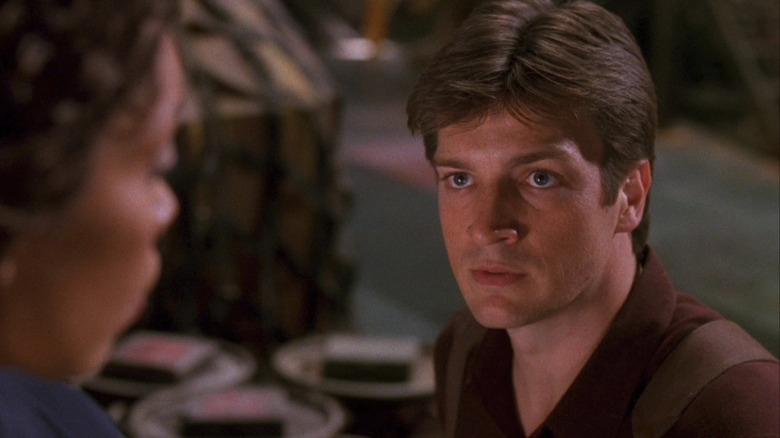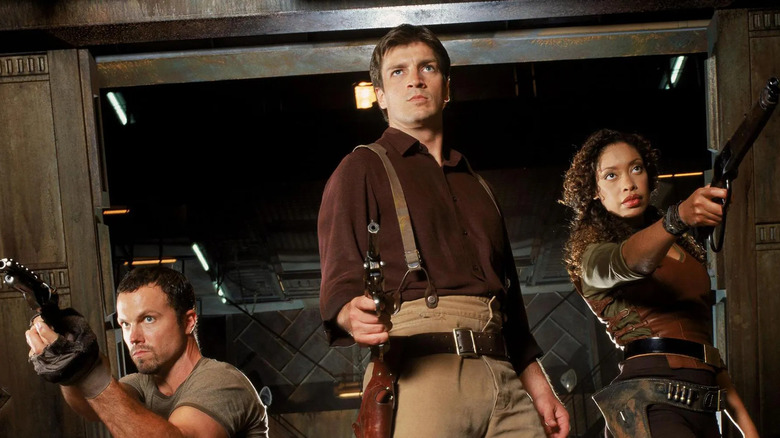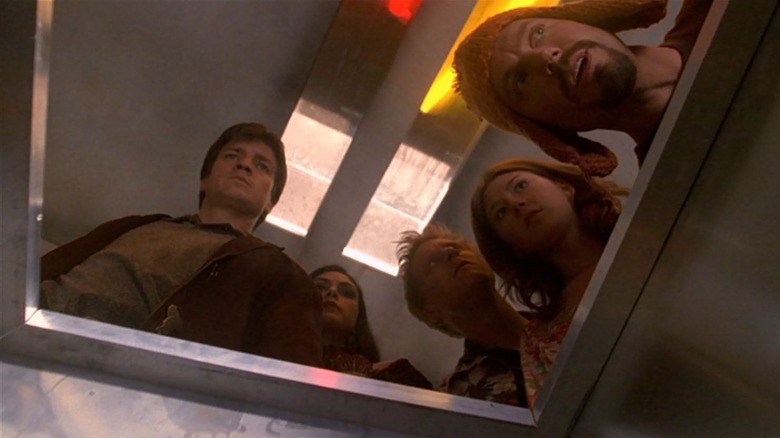Firefly's Most Difficult Shot Was One Of The First That Nathan Fillion Filmed
Joss Whedon's and Tim Minear's 2002 sci-fi series "Firefly" was, for many years, held up as the ur example of pop culture-related missed opportunities. The show lasted only 14 episodes and aired from September to December. Despite being aired out-of-order, "Firefly" accrued an enormously passionate cult following, likely following Whedon over from his other successful shows "Buffy the Vampire Slayer" and its spin-off, "Angel." When "Firefly" was released on DVD, its cult audience expanded as fans were now able to see the arc of the series presented properly. Eventually, "Firefly" gained enough cultural traction to warrant a follow-up feature film, 2005's "Serenity." The film was meant, according to fan scuttlebutt, to be the show's unmade second season condensed into 119 minutes. Since 2005, "Firefly" has remained in the realm of board games and tie-in comic books. Since the ousting of Whedon for alleged bad behavior on various sets, demands for a reboot or resurrection of "Firefly" have cooled.
Nathan Fillion stars as Malcolm Reynolds, the captain of a spacecraft called the Serenity. The show takes place in the 26th century, when a massive solar system with hundreds of planets has been extensively terraformed. The inner planets of the system are well-moneyed, and overseen by the vaguely sinister Alliance. The outer worlds are impoverished and resemble the Old West, complete with trains and horses. Captain Reynolds (aka "Mal"), previously on the losing side of a recent Civil War, has now gathered an eclectic group of crewmates to make a living smuggling illicit goods.
As one might assume, the pilot episode of "Firefly" needed to establish the geography of the tiny Serenity spacecraft for audiences. According to the 2006 sourcebook "Firefly: The Official Companion," written by Whedon and Abbie Bernstein, the establishing shot was one of the hardest ever constructed for the series.
Cramped quarters
It's worth noting that the Serenity is a tiny ship. Every room is cramped, except for the main cargo area, which is always cluttered. Mal and his crew are often disorganized and don't have the money to clean and maintain their ship properly. As such, the cinematographers of "Firefly" had to find creative ways to film action in such a small, busy space.
The shot in question involved altering the set and constructing special runners for the camera so it could follow Mal up a ladder from his below-decks sleeping quarters and up into the ship's main hallway. Whedon described it like this:
"The most difficult shot we did is in the pilot. It's Mal coming out of his quarters on the ladder. The camera is in his quarters and then goes up the ladder above him and into the hall. That required building a piece of the hall above his room and [cinematographer] David [Russell Boyd] and his guys designing a rig that they attached the camera to, that basically ran on tracks which they attached to the ceiling, so they could stick the camera all the way down in the room."
While the shot could have been split into two, with an edit to the reverse angle, the showrunner clearly wanted a more organic flow. The shot was also handy at establishing the geography of an otherwise weirdly designed spacecraft.
'We are a little band of brothers'
However, the shot didn't quite work, and Whedon asked for a re-do.
"I actually asked them to adjust it and the next day, they had completely reworked it so you went up the track and then they'd literally pull it with a rope, while someone was operating the head of the camera so that it could look down. It could go up and then go out again when he came up the hall, so that it really felt like it was just hanging with him."
That kind of can-do attitude was not only appreciated on the set of "Firefly," but reflected a type of low-budget filmmaking Whedon associated with low-budget live performances. Limited resources require both an increased amount of creativity and can also foster a certain kind of filmic camaraderie. "Firefly" had a decent budget, but it felt scrappy and, perhaps as a result, more genuine. That scrappiness is likely what initially attracted so many fans. As Whedon said:
"[T]hat kind of last-minute, low-rent but elaborate inventiveness to get that feeling of being there was something that I adored, that I got from everybody I worked with and that I thrived on, because we were making something that felt very epic, but at the same time, it felt so little regional theatre, intimate, no-budge [no-budget], we are a little band of brothers, little artists having our moment. And that kind of energy is very rare in television."
Overall, "Firefly" is a little clunky, and takes a while to get on its feet. Unfortunately, that was a major detriment for a series that was only going to last 14 episodes. But fans loved the characters, and Nathan Fillion became a cult icon. Something obviously struck a chord, and the show's visual flair helped cement its reputation.


